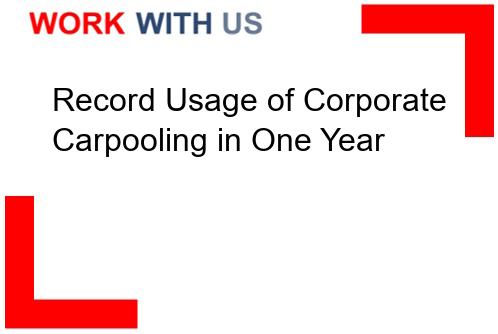In the span of just one year, corporate carpooling has witnessed an unprecedented surge in popularity, revolutionizing the way employees commute to work. This innovative transportation solution has not only alleviated traffic congestion and reduced carbon emissions but has also fostered a sense of camaraderie among colleagues. With record-breaking numbers, the adoption of corporate carpooling has become a remarkable success story, transforming the daily commute into a more efficient and sustainable experience.
The concept of carpooling, where multiple individuals share a vehicle to travel together, has been around for decades. However, it is only in recent years that corporations have recognized its potential as a viable solution to address the challenges posed by commuting. In the past year alone, the number of companies implementing carpooling programs has skyrocketed, leading to a significant increase in its usage.
One of the primary reasons behind the surge in corporate carpooling is the growing awareness of its environmental benefits. As organizations strive to reduce their carbon footprint, carpooling presents an attractive solution to minimize the number of vehicles on the road. By encouraging employees to share rides, companies have witnessed a substantial decrease in the emission of greenhouse gases, contributing to a greener and more sustainable future.
Moreover, the financial advantages of carpooling have also played a crucial role in its record-breaking usage. With rising fuel costs and parking fees, employees have embraced the opportunity to split these expenses, resulting in significant savings. By sharing the burden of commuting costs, carpooling has not only lightened the financial load on individuals but has also allowed companies to allocate resources more efficiently.
Beyond the environmental and financial benefits, corporate carpooling has fostered a sense of community among employees. By spending time together during the commute, colleagues have found opportunities to connect, share ideas, and build stronger relationships. This newfound camaraderie has not only improved workplace dynamics but has also enhanced overall employee satisfaction and engagement.
To facilitate the widespread adoption of carpooling, companies have implemented user-friendly platforms and applications. These digital tools allow employees to easily find and connect with potential carpool partners, ensuring a seamless and efficient experience. By leveraging technology, organizations have successfully overcome the logistical challenges associated with carpooling, further contributing to its record usage.
The success of corporate carpooling can also be attributed to the support and encouragement from management. Many companies have introduced incentives and rewards programs to motivate employees to participate in carpooling initiatives. These incentives range from preferred parking spots to financial bonuses, creating a positive reinforcement system that has significantly contributed to the surge in usage.
Looking ahead, the future of corporate carpooling appears promising. As more organizations recognize the benefits of this transportation solution, it is expected that the record-breaking usage will continue to rise. With the potential to reduce traffic congestion, lower carbon emissions, and foster a sense of community, carpooling has proven to be a transformative force in the corporate world, revolutionizing the way employees commute to work.
The impact of corporate carpooling on reducing carbon emissions: a year in review
In today’s world, where environmental concerns are at the forefront of global discussions, finding innovative solutions to reduce carbon emissions has become a top priority. One such solution that has gained significant attention is corporate carpooling. By encouraging employees to share rides to and from work, companies can play a crucial role in minimizing their carbon footprint. As the year comes to a close, it is essential to review the impact of corporate carpooling on reducing carbon emissions.
Over the past year, numerous companies have implemented carpooling programs as part of their sustainability initiatives. These programs have not only helped reduce the number of vehicles on the road but have also fostered a sense of camaraderie among employees. By sharing rides, employees have had the opportunity to connect with colleagues from different departments, leading to improved teamwork and collaboration within the workplace.
One of the most significant advantages of corporate carpooling is its positive impact on the environment. By reducing the number of vehicles on the road, carpooling has contributed to a substantial decrease in carbon emissions. According to recent studies, a single carpooling vehicle can reduce carbon emissions by up to 20%. When multiplied by the number of employees participating in these programs, the reduction in carbon emissions becomes even more significant.
Moreover, corporate carpooling has also had a positive effect on traffic congestion. With fewer vehicles on the road, rush hour traffic has been noticeably alleviated, resulting in shorter commute times for employees. This, in turn, has led to increased productivity and reduced stress levels among workers. By providing a more efficient and enjoyable commute experience, carpooling has proven to be a win-win situation for both employees and employers.
In addition to its environmental and traffic-related benefits, corporate carpooling has also had a positive impact on employees’ financial well-being. By sharing the cost of fuel and parking, employees participating in carpooling programs have been able to save a significant amount of money. This financial relief has not only improved employees’ overall satisfaction but has also contributed to increased employee retention rates for companies.
Furthermore, corporate carpooling has also encouraged the use of alternative transportation methods. Many companies have partnered with local public transportation authorities to provide discounted or free passes to employees who carpool. This has not only reduced the number of private vehicles on the road but has also promoted the use of greener transportation options such as buses and trains. By integrating carpooling with public transportation, companies have taken a step further in their commitment to reducing carbon emissions.
However, it is important to acknowledge that implementing and maintaining a successful corporate carpooling program comes with its challenges. Companies must invest in robust communication platforms and technologies to facilitate ride-sharing arrangements among employees. Additionally, ensuring a fair and equitable distribution of carpooling responsibilities can be a complex task. Companies must establish clear guidelines and policies to address potential conflicts and ensure a smooth carpooling experience for all participants.
In conclusion, the impact of corporate carpooling on reducing carbon emissions has been significant over the past year. By encouraging employees to share rides, companies have not only contributed to a greener environment but have also fostered a sense of community and collaboration within their workforce. The positive effects of carpooling extend beyond the reduction in carbon emissions, with benefits such as reduced traffic congestion, financial savings, and the promotion of alternative transportation methods. As we move forward, it is crucial for companies to continue investing in and promoting carpooling programs as part of their commitment to sustainability and a greener future.
Analyzing the cost savings of corporate carpooling: a comprehensive study
Carpooling has gained significant attention in recent years as a sustainable transportation solution for reducing traffic congestion and carbon emissions. In addition to its environmental benefits, carpooling also offers potential cost savings for corporations. This comprehensive study aims to analyze the financial implications of implementing a corporate carpooling program, taking into account various factors such as fuel costs, maintenance expenses, and employee productivity.
Fuel cost savings
One of the most significant cost savings associated with corporate carpooling is the reduction in fuel expenses. By encouraging employees to share rides, companies can significantly decrease the amount of fuel consumed for commuting. This not only leads to direct cost savings but also contributes to a greener corporate image. A study conducted by the American Automobile Association (AAA) found that carpooling can save up to 30% on fuel costs compared to individual commuting. These savings can be substantial, especially for companies with a large workforce or those located in areas with high fuel prices.
Maintenance and parking expenses
Implementing a corporate carpooling program can also result in reduced maintenance and parking expenses for companies. With fewer vehicles being driven to the workplace, the wear and tear on company parking lots and garages are significantly reduced. This translates into lower maintenance costs for repairing and repaving parking areas. Moreover, companies can potentially downsize their parking facilities, leading to long-term cost savings. Additionally, carpooling reduces the number of vehicles on the road, which can help alleviate traffic congestion and decrease the need for costly road repairs.
Employee productivity
While cost savings are often associated with tangible financial benefits, corporate carpooling can also positively impact employee productivity. By sharing rides, employees can utilize travel time more efficiently, engaging in work-related activities such as checking emails, making phone calls, or preparing for meetings. This increased productivity during commuting hours can result in significant time savings for employees, allowing them to allocate more time to their core responsibilities. Furthermore, carpooling can foster better relationships among colleagues, leading to improved teamwork and collaboration within the organization.
Reduced absenteeism and turnover
Another indirect cost saving associated with corporate carpooling is the potential reduction in employee absenteeism and turnover. Long and stressful commutes can often lead to increased absenteeism due to transportation-related issues. By providing employees with a carpooling option, companies can help alleviate some of the stress associated with commuting, resulting in improved attendance rates. Additionally, carpooling can enhance employee satisfaction and work-life balance, which in turn can reduce turnover rates. This is particularly relevant for companies located in areas with limited public transportation options or high commuting distances.
Tax incentives and subsidies
Governments and local authorities often provide tax incentives and subsidies to companies that promote sustainable transportation solutions such as carpooling. These incentives can further enhance the cost savings associated with corporate carpooling programs. For example, some jurisdictions offer tax credits or deductions for companies that encourage carpooling among their employees. Additionally, governments may provide subsidies for the implementation of carpooling infrastructure or the purchase of vehicles specifically designated for carpooling purposes. By taking advantage of these incentives, companies can maximize their cost savings and further promote sustainable transportation practices.
In conclusion, implementing a corporate carpooling program can result in significant cost savings for companies. By reducing fuel costs, minimizing maintenance and parking expenses, improving employee productivity, and reducing absenteeism and turnover rates, carpooling offers a comprehensive solution for both financial and environmental benefits. Furthermore, tax incentives and subsidies provided by governments can further enhance the cost savings associated with corporate carpooling. As companies strive to adopt sustainable practices and reduce their carbon footprint, carpooling emerges as a viable and cost-effective transportation solution.
Enhancing employee engagement through corporate carpooling: lessons from a year of success
In today’s fast-paced world, companies are constantly seeking innovative ways to enhance employee engagement and promote sustainable practices. One such solution that has gained significant traction is corporate carpooling. By encouraging employees to share rides to and from work, organizations can not only reduce their carbon footprint but also foster a sense of camaraderie and teamwork among their workforce.
Over the past year, numerous companies have successfully implemented corporate carpooling programs, reaping the benefits of increased employee engagement and improved overall satisfaction. These organizations have learned valuable lessons along the way, which can serve as a guide for others looking to embark on a similar journey.
First and foremost, effective communication plays a pivotal role in the success of any corporate carpooling initiative. Companies that have excelled in this area have implemented comprehensive communication strategies to ensure that all employees are aware of the program and its benefits. From initial announcements to regular reminders, they have utilized various channels such as email, intranet, and notice boards to reach out to their workforce.
Furthermore, these companies have recognized the importance of incentivizing participation in the carpooling program. By offering rewards such as preferred parking spots, flexible work hours, or even financial incentives, they have motivated employees to actively engage in carpooling. This not only encourages employees to consider carpooling as a viable option but also fosters a sense of appreciation for their commitment towards sustainable practices.
Another crucial aspect that successful companies have focused on is the creation of user-friendly platforms or apps to facilitate carpool coordination. By leveraging technology, employees can easily connect with potential carpool partners, plan routes, and manage schedules. These platforms also provide a means for employees to provide feedback, report issues, and suggest improvements, thereby ensuring continuous enhancement of the carpooling experience.
Moreover, companies have recognized the importance of flexibility in their carpooling programs. They understand that not all employees have the same commuting needs or schedules. By offering flexible arrangements, such as allowing employees to choose their carpool partners or providing options for occasional solo drives, these organizations have ensured that the program caters to the diverse needs of their workforce.
Additionally, successful companies have actively engaged with their employees to gather feedback and assess the impact of the carpooling program. Regular surveys, focus groups, and open forums have allowed employees to voice their opinions, share their experiences, and suggest improvements. This two-way communication has not only strengthened the program but also made employees feel valued and heard.
Furthermore, these organizations have recognized the importance of continuous promotion and awareness-building. They have organized events, workshops, and campaigns to educate employees about the benefits of carpooling, sustainability, and the positive impact on their overall well-being. By creating a culture that values and promotes carpooling, these companies have successfully ingrained the practice into their organizational DNA.
Lastly, successful companies have celebrated milestones and achievements related to their carpooling programs. By recognizing and rewarding employees who have actively participated in carpooling, they have created a sense of pride and accomplishment. This not only encourages existing participants to continue their efforts but also inspires others to join the initiative.
In conclusion, corporate carpooling has proven to be an effective tool for enhancing employee engagement and promoting sustainable practices. Companies that have successfully implemented carpooling programs have learned valuable lessons along the way. From effective communication and incentivization to user-friendly platforms and flexibility, these organizations have created a culture that values and promotes carpooling. By actively engaging with employees, gathering feedback, and continuously promoting awareness, they have achieved remarkable success in enhancing employee engagement through corporate carpooling.
Exploring the challenges and solutions of implementing corporate carpooling programs: a yearlong analysis
Implementing corporate carpooling programs can present a range of challenges, but with careful planning and effective solutions, these programs can offer numerous benefits to both companies and employees. A yearlong analysis of such programs reveals the complexities involved and highlights the need for innovative strategies to overcome obstacles. This comprehensive exploration will delve into the challenges faced during the implementation of corporate carpooling programs and propose potential solutions to ensure their success.
1. Infrastructure and Logistics
One of the primary challenges in implementing corporate carpooling programs is the need for adequate infrastructure and logistics. Companies must consider factors such as parking space availability, designated pick-up and drop-off points, and efficient routing to accommodate multiple employees sharing a ride. Insufficient parking space can discourage employees from participating in the program, while inefficient routing can lead to delays and inconvenience. To address these challenges, companies can invest in technology-driven solutions, such as carpooling apps, that optimize routing and provide real-time updates to participants. Additionally, companies can collaborate with local authorities to secure dedicated carpooling lanes or parking areas, making the program more attractive and convenient for employees.
2. Employee Participation and Incentives
Encouraging employee participation is another significant hurdle in implementing successful carpooling programs. Employees may be reluctant to share rides due to concerns about flexibility, privacy, or compatibility with co-workers. To overcome this challenge, companies can offer incentives to motivate employees to participate. These incentives can include preferred parking spots, reduced parking fees, or even financial rewards. Moreover, companies can promote the environmental and cost-saving benefits of carpooling, emphasizing the positive impact on reducing traffic congestion and carbon emissions. By creating a culture that values carpooling, companies can increase employee engagement and participation in these programs.
3. Communication and Awareness
Effective communication and awareness campaigns are crucial for the success of corporate carpooling programs. Many employees may be unaware of the program’s existence or the benefits it offers. Companies should develop comprehensive communication strategies to inform employees about the program, its objectives, and the steps required to participate. Utilizing various channels, such as email newsletters, intranet portals, and physical posters, can help reach a wider audience. Additionally, companies can organize informational sessions or webinars to address employee concerns and provide a platform for questions and feedback. By fostering open communication and raising awareness, companies can ensure maximum participation and engagement in their carpooling programs.
4. Legal and Liability Considerations
Legal and liability concerns pose significant challenges when implementing corporate carpooling programs. Companies must navigate various legal frameworks, including insurance coverage, liability waivers, and compliance with transportation regulations. It is essential to consult legal experts to ensure compliance with local laws and regulations. Companies can also consider partnering with carpooling service providers that offer comprehensive insurance coverage for participants. By addressing legal and liability concerns proactively, companies can mitigate risks and provide a secure environment for employees participating in carpooling programs.
5. Flexibility and Adaptability
Flexibility and adaptability are key factors in the success of corporate carpooling programs. Employees may have varying schedules, work locations, or personal commitments that make carpooling challenging. To address this, companies can implement flexible policies that allow employees to participate in carpooling on specific days or during certain hours. Additionally, companies can explore alternative transportation options, such as shuttle services or vanpooling, to accommodate employees with diverse needs. By offering flexible solutions and adapting to employee preferences, companies can ensure the long-term viability and success of their carpooling programs.
In conclusion, implementing corporate carpooling programs presents a range of challenges, including infrastructure and logistics, employee participation, communication, legal considerations, and flexibility. However, by addressing these challenges with innovative solutions, companies can reap the benefits of reduced traffic congestion, lower carbon emissions, and improved employee satisfaction. Through careful planning, effective communication, and a commitment to adaptability, corporate carpooling programs can become an integral part of sustainable transportation strategies for companies worldwide.



